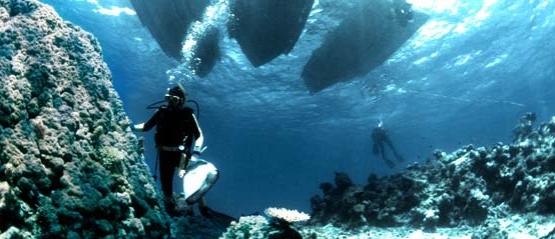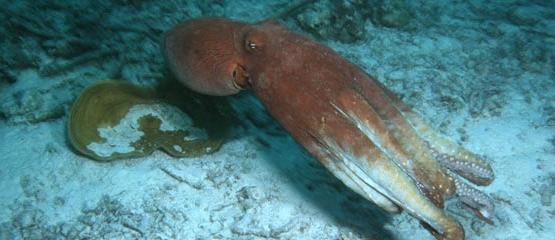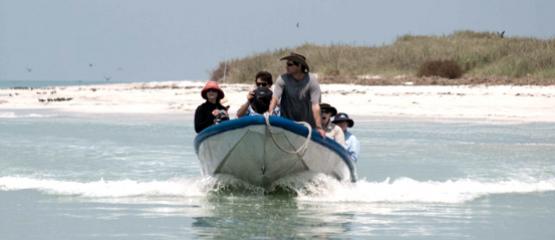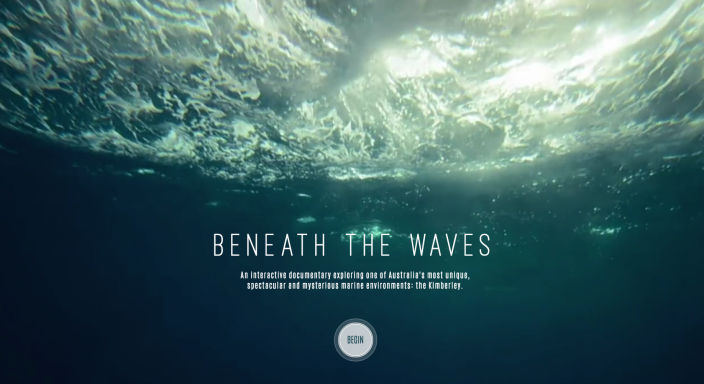Beneath the Waves Interactive Documentary
One vessel, 476,000 sq km of ocean, 2,500 islands, raging 11-metre tides, astounding unexplored reefs and a plethora of amazing flora and fauna. An entire aquatic universe is waiting to be discovered.




Marine Life of the Kimberley Region
The Marine Life of the Kimberley Project is the website name for two marine biological projects officially called, The Woodside Collections Project (Kimberley) 2008-2011, referred to here as Phase 1 and The Woodside Collections Project (Kimberley) 2011-2015, Phase 2. Both projects are exploring the marine biodiversity of the inshore Kimberley and the associated continental shelf out to the shelf-edge coral atolls.

- Marine research expedition
- Photograph by Clay Bryce
- Copyright Western Australian Museum
About the Projects (phase 1: 2008 to 2011 and phase 2: 2011 to 2015)
The Marine Life of Kimberley project (phase 1: 2008 to 2011) involved the analyses of historic Kimberley marine biodiversity data from several Australian museums and the WA Herbarium. This data was combined with information from published and unpublished survey reports to give the current state of knowledge for the region’s marine biodiversity. These data sets were used to examine various environmental, biogeographical and taxonomic aspects of the Kimberley region. Another part of this first phase was to undertake two modern surveys of the inshore Kimberley to examine faunal differences between the southern and northern Kimberley. The results of this work are in the process of being published.
Phase 2 (2011 – 2015) is a series of surveys to increase the resolution of the marine biodiversity data examined during Phase 1. These surveys will examine the marine fauna and flora at selected sites along the whole Kimberley coast, out onto continental shelf as far north as Ashmore and Hibernia Reefs.
All the marine surveys (2009 -2014 inclusive) are targeting the region’s worms, molluscs, crustaceans, fish, soft and hard corals, sponges, echinoderms and marine plants. Water quality is also being measured.
The Marine Life of the Kimberley Project will provide a wealth of information, contributing toward informed decision making, sustainable development, formulation of business and conservation policies, the provision of educational input and assessment of national and world heritage values.
Follow our exploits and discoveries on video in the Live Action section of this website.
The Kimberley Region

- Kimberley project area
- Map copyright Western Australian Museum.
The Kimberley coast stretches from Broome to the Western Australian – Northern Territory border, covering about 15,000 kilometres. It is a rugged and remote place with high cultural and heritage values and a wealth of marine life ruled by huge 10 metre tides.
The marine life of the inshore Kimberley is not well known. Most of what is known is held within the collections of the Western Australian Museum and other Australian museums and research agencies. Future marine survey work during 2011 to 2014 will help to alleviate this knowledge gap.
The coastline boasts fiord-like cliffs and white sandy beaches festooned with rocky shores and mangrove forests. Offshore there are some 2,500 islands fringed with seagrass meadows, coral reefs, tidally–drained mud flats and rich sponge gardens. The habitats are diverse and the biodiversity rich. Massive humpback whales, nesting turtles, myriad invertebrate life and fish all abound in the warm Kimberley waters. However, while public and industrial interest in this frontier region grows the biodiversity remains largely unknown.

- Octopus cyanea
- Photograph by Clay Bryce
- Copyright Western Australian Museum
The Atolls of Western Australia’s Continental Shelf
From latitude 17°40' S and spanning north along the edge of the continental shelf out from Broome, is a series of atolls and reefs. The first is the Rowley Shoals made up of three atolls, next in line is Scott and Seringapatam Reefs, followed by Ashmore and Hibernia Reefs, just south of Indonesia. Midway between the Kimberley coast and this chain of outer reefs is another line of small, isolated shoals, and a single island called Browse Island. These remote sites are ‘oases of life’ and represent a unique habitat for Western Australian marine fauna.
In 1983 the Western Australian Museum conducted a marine biodiversity survey of the continental-edge atolls at Rowley Shoals, Scott and Seringapatam reefs. The findings were published as a Supplement to the Western Australian Museum Records in 1986. Twenty years later, in 2006, through generous support from Woodside Energy, a subsequent survey was undertaken. As with the earlier 1983 survey, this new survey investigated the biodiversity of the reefs. The results represent a significant contribution to our knowledge of this remote oceanic region (see Publications).

- Underwater scene
- Photograph by Clay Bryce
- Copyright Western Australian Museum
About the Project
The Marine Life of Kimberley project (phase 1: 2008 to 2011) involved the analyses of historic Kimberley marine biodiversity data from several Australian museums and the WA Herbarium. This data was combined with data from published and unpublished survey reports to give a state of current knowledge for the region’s marine biodiversity. These data sets were used to examine various environmental, biogeographical and taxonomic aspects of the Kimberley region. The results of this work are in the process of being published. Another part of this first phase was to undertake two modern surveys of the inshore Kimberley to see if there were any major faunal differences between the southern and northern Kimberley.
Phase 2 (2011 – 2015) is a series of surveys to increase the resolution of the marine biodiversity data examined during Phase 1. These surveys will examine the marine fauna and flora at selected sites along the Kimberley coast, out onto the mid-continental shelf and as far north as Ashmore and Hibernia Reefs.
All the marine surveys (2009 -2014) will target the region’s worms, molluscs, crustaceans, fish, corals, soft corals, sponges and echinoderms, marine algae and seagrasses as well as measuring water quality. Follow our exploits and discoveries on video in the Live Action section of this website.
The Marine Life of the Kimberley Project will provide a wealth of information, contributing toward informed decision making, sustainable development, formulation of business and conservation policies, the provision of educational input and assessment of national and world heritage values.
Follow our exploits and discoveries on video in the Live Action section of this website

- Intertidal research party
- Photograph by Clay Bryce
- Copyright Western Australian Museum
The Coral Compactus: Western Australia Hard Coral Genus Identification Guide Version 1.1
This guide has been put together by Western Australian Museum Aquatic Zoology Research Scientist Zoe Richards.
Abstract: The intention of this identification guide is to provide coral identification material to support teaching, research, monitoring and biodiversity conservation in Western Australia. This coral identification manual provides an introduction to the characteristics required to identify to genus level shallow-water, reef building corals. It provides summary descriptions of the most useful characters used to distinguish all coral genera known to occur in Western Australia. This manual should be used in conjunction with other taxonomic sources (see reference list).

The Team
The Western Australian Museum and Woodside Energy have once again joined forces. Our first award-winning partnership (1998–2006) explored the marine biodiversity of the Dampier Archipelago in North Western Australia.
For Phase 1 (2008 – 2011) The Marine Life of the Kimberley Project the Western Australian Museum, in conjunction with the Australian Museum, the Museum and Art Gallery of the Northern Territory, the Queensland Museum and Museum Victoria, analysed the known marine fauna from their considerable databases and associated scientific literature. The marine flora were included in collaboration with the Western Australian Herbarium (Department of Environment and Conservation). During 2009 and 2010 the above agencies undertook two marine biodiversity surveys (see Live Action, Researcher’s Diaries and Station Diaries on this website). The data from these surveys, when combined with the above datasets, will greatly increase our understanding of the marine life of this amazing region.
Awards
Western Australia 2011 Premier's Awards
 The Western Australian Museum’s Exploring the Marine Biodiversity of Northern WA project was announced as the winner of the 2011 Premier’s Award for Excellence in Public Sector Management. The project was also selected as the winner in the Managing Environment category.
The Western Australian Museum’s Exploring the Marine Biodiversity of Northern WA project was announced as the winner of the 2011 Premier’s Award for Excellence in Public Sector Management. The project was also selected as the winner in the Managing Environment category.
2011 Museums Australia Awards
 The Marine Life of the Kimberley Region won the award for best large institution website at the Museums Australia Multimedia and Publications Design Awards in 2011.
The Marine Life of the Kimberley Region won the award for best large institution website at the Museums Australia Multimedia and Publications Design Awards in 2011.
2011 Australian Web Awards
 The Western Australian Museum’s Marine Life of the Kimberley Region website was a finalist in the Western division of 2011 Australian Web Awards in the category of innovation.
The Western Australian Museum’s Marine Life of the Kimberley Region website was a finalist in the Western division of 2011 Australian Web Awards in the category of innovation.



